


 |
May 9-12, 1994: A Trip to Washington, D.C. |
 |
March 20, 1994: A Visit to the Dallas Arboretum |
 |
Return to the Index for 1994 |
On the last weekend in April, Fred and I drove down to Austin to meet Frank and Joe, Fred's friends from South Texas and the guys I got Chip and Dale from. They wanted to get away from their ranch, and we wanted to see them without driving down to Leakey, so meeting in Austin was ideal.
Getting to Austin
|
I made reservations for all four of us at the La Quinta downtown, which was very convenient, and Fred and I left right after work on Friday, ate in Temple on the way down, and arrived about nine-thirty. Frank and Joe had been vague as to what time they would arrive; it's a 100+-mile trip for them and not expressway, so the traffic can be unpredictable. We checked in and discovered they had not yet arrived, and so we changed clothes and went out to San Francisco's (the C&W) bar that Frank and Joe had recommended as a meeting place.
When we got there, we found that the bar had changed into a women's bar, and Frank and Joe were nowhere to be found. We decided to go to the Chain Drive, thinking they would have gone there instead, and were on our way over when they pulled up beside us at a traffic light.
We spent some time in the Chain Drive having a drink and talking, and we found out that the new C&W bar was called "Seventh Street Station". We decided to head over there to check it out for a while before heading back to the hotel.
Frank and Joe got checked in and we planned to meet for breakfast.
The Texas State Capitol
|
The current Texas State Capitol is actually the third building to serve that purpose. The first was little more than a farmhouse in 1836, and the second Texas capitol was built in 1853, on the same site as the present capitol. It was destroyed in the great capitol fire of 1881, but plans had already been made to replace it with a third, much larger structure.
Construction of the Italian Renaissance Revivalstyle capitol was funded from the sale of public lands for the purpose. In one of the largest barter transactions of recorded history, the builders of the capitol were paid with more than three-million acres of public land in the Texas Panhandle; this tract later became the largest cattle ranch in the world, the XIT Ranch. Based on the land grant value and the actual recorded expenses, the total cost was nearly $4 million, which doesn't seem like much, but that's well over half a billion dollars today. The crew was largely convicts and migrant workers, as many as a thousand at a time. The building has been renovated several times, with central air conditioning installed in 1955.
|
|
None of us had been to the Capitol in a while, so we thought we should walk around and see as much of the restoration going on as we could, and also tour through the new underground House and Senate office building.
The cornerstone for the building was laid on March 2, 1885, Texas Independence Day, and the completed building was opened to the public on April 21, 1888, San Jacinto Day. The designers originally planned for the building to be clad entirely with hill country limestone quarried in present-day Oak Hill, about 10 miles to the southwest. However, the high iron content of the limestone led it to rapidly discolor with rust stains when exposed to the elements. Learning of the problem, the owners of Granite Mountain near Marble Falls offered to donate to the state, free of charge, the necessary amount of sunset red granite as an alternative. While the building is mostly built of the Oak Hill limestone, most of this is hidden behind the walls and on the foundations. Red granite was subsequently used for many state government buildings in the Austin area.
On February 6, 1983 a fire began in the lieutenant governor's apartment; it was intense and did much damage. Repairs and restoration continued until 1993, and the state took advantage of the extensive rebuilding to update the mechanical and structural systems to modern standards and also to deal with the intensifying shortage of space in the old building, deciding that a new office wing should be added. The logical place for an addition was the plaza immediately to the north; however, a large building there would have eliminated the historic north façade and covered what had traditionally been seen as an important public space. Instead, an expansion to the capitol was built beneath the north plaza, connecting to the existing capital underground.
The underground extension provided a great deal of additional space, but there is little evidence of the new 700,000-square-foot building at ground level, except for extensive skylights camouflaged as planter rows, and the four-story open-air inverted rotunda, where we walked to next, descending into the new structure from the main building and then walking through it and out into the open-air atrium.
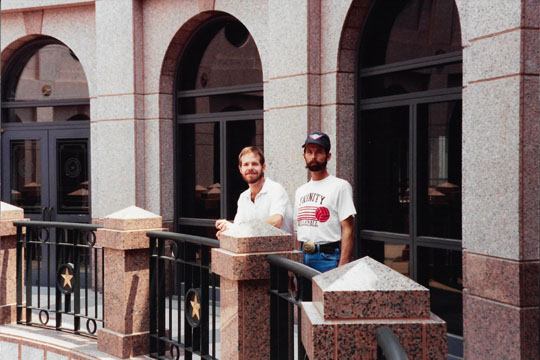 Me and Joe in the Inverted Rotunda As you have seen in earlier pictures, the new Senate office building is built underground behind the Capitol itself. We took the elevator down into the complex. In the center of it is an underground rotunda covered by a huge skylight. |
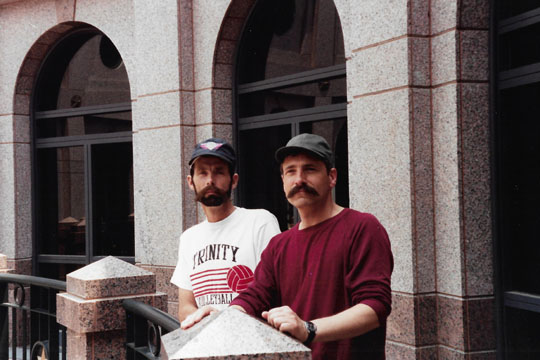 Joe and Frank in the Inverted Rotunda We are actually below ground here, looking up through a skylight. This rotunda, along with six huge covered skylights and an open-air atrium, allow a great deal of light into the offices below ground. The whole thing is made of beautiful Texas granite and marble. |
The capitol has 360,000 square feet of floor space (not including the Capitol Extension), more than any other state capitol building, and rests on 2.25 acres (of land. The building has nearly four hundred rooms and more than nine hundred windows. We continued walking through the halls of the underground structure until we came into the open-air atrium (which you can see on the aerial view above.
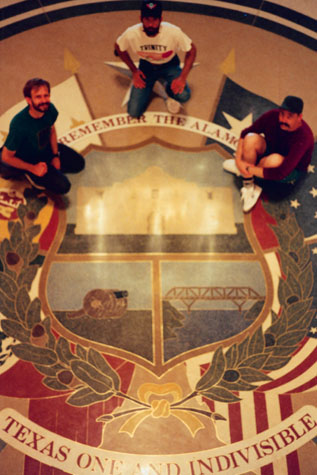 On the Floor of the Rotunda |
(Picture at left) I thought this inlaid design on the floor of the Rotunda was neat, so I went up one level to the balcony to take a picture of the three of them and it. The light was low, so I had to use a slow speed, and you can see the fuzziness. The design is flanked by the six flags under which Texas has lived, and the pictures in the center each represent a major aspect of the state or of its history, like the Alamo on the top.
(Picture at right)
|
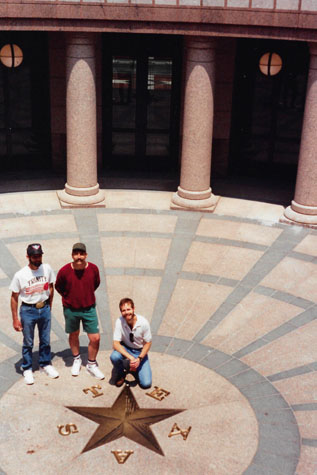 In the Open-Air Atrium |
The interior of the central rotunda features portraits of every person who has served as president of the Republic of Texas or governor of the State of Texas; the rotunda is also a whispering gallery. The south foyer features a large portrait of David Crockett, a painting depicting the surrender of General Santa Anna at the Battle of San Jacinto, and sculptures of Sam Houston and Stephen F. Austin made by Elisabet Ney. The Capitol was ranked ninety-second in the "America's Favorite Architecture" poll commissioned by the American Institute of Architects- the highest ranking for a state capitol. We wandered through the new office extension for a while, looking at the artwork and stuff, and then went back up to the plaza and across the street to the Texas State Archives.
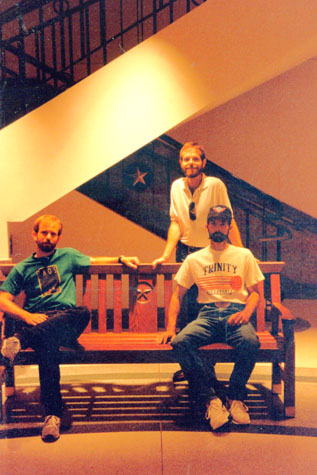 Inside the Senate Office Building |
(Picture at left) In those areas of the underground structure not directly adjacent to an outside light source, there is very pleasant artificial light. Fred liked the carved oak furniture throughout the public areas of the building. I had Frank take this picture.
(Picture at right)
|
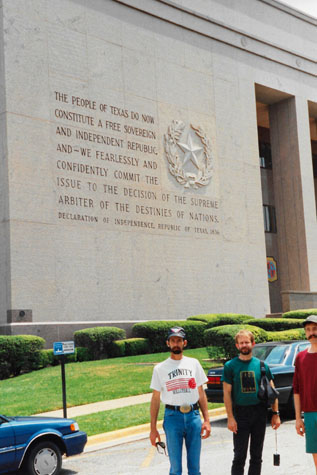 Outside the Texas State Archives |
The Capitol building is surrounded by 22 acres of grounds scattered with statues and monuments. William Munro Johnson was hired in 1888 to improve the appearance of the grounds. By the time the first monument, commemorating the Heroes of the Alamo, was installed in 1891, the major components of Johnson's plan were in place. These included a "Great Walk" of black and white diamond-patterned pavement shaded by trees. We went into the Archives to look at the exhibits.
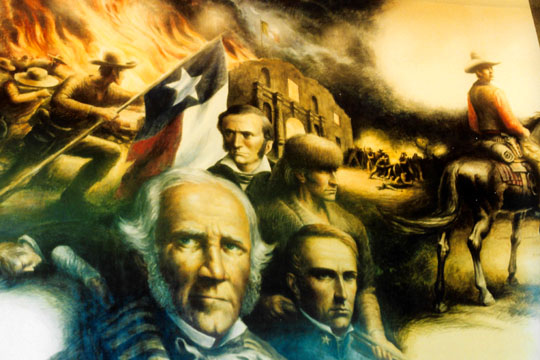 Part of the Texas History Mural Inside the Texas State Archives |
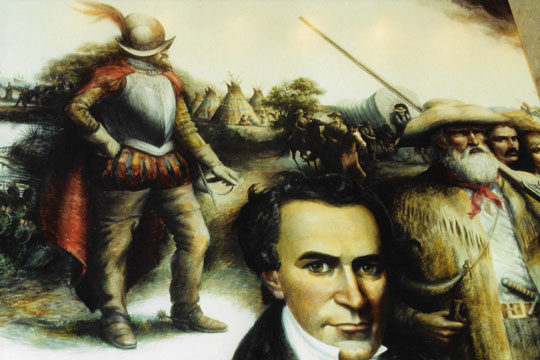 Part of the Texas History Mural Inside the Texas State Archives |
The entire Capitol complex was within a two-block walk of the hotel, so we went back there to relax for a few minutes before heading out to Lake Travis.
Lake Travis and "Hippie Hollow"
|
Because of its volume, the lake serves as the primary flood control reservoir of the Highland Lake chain. The level of the lake can therefore vary dramatically, depending on the amount of rainfall in the Colorado River basin upstream. Despite this, the lake furnishes one of the most desired locations in the region for outdoor recreation, including fishing, boating, swimming, scuba diving, picnicking, camping, and zip lining.
I first came to Lake Travis in 1987 when a then friend and his partner invited Grant and I to spend a weekend on their boat during "Splash Day", a predominantly gay-oriented boat party where everyone with a watercraft anchors below the bluffs near the dam for two days of partying. We returned there a couple of times before Grant died, but this is the first time that Fred and I have been there.
|
We drove out to the lake specifically to pay a visit to this particular part of it. Just in case someone hasn't gotten the word, there is a big sign at the top of the pathway down to the cliffs that Hippie Hollow is a "clothing optional" area. There is an overlook right near the parking area, and that's where I took the picture at right of Fred.
We got there in mid-afternoon, parked, and then walked down to the cliffs that surround this end of the lake. It is a bit disconcerting to be walking along (we were all wearing at least a pair of shorts) and pass men and women (mostly men) totally naked. Of course, for voyeurs like us, it's very interesting. We walked over to the gay portion, and settled down to enjoy the sun and watch the scenery (of all kinds). I like it because there are lots of rocks to climb around on.
Lake Travis is generally considered one of the clearest lakes in Texas. It is a vital water supply for the nearby city of Austin, Texas and the surrounding metropolitan area.
We left about five, and on the way back to the car passed a naked man that we all thought attractive. He greeted us and said something like "have a good time tonight." We drove back to the city, relaxed, and then went to the Spaghetti Warehouse to eat. After dinner, we were waiting in the anteroom while Frank was in the head, when the same guy walked in (fully clothed). He went in to use the restroom, and I was the one who identified him from the afternoon. When he came out and walked by us, he looked at us again and said something like "it looks like you're having a good time" so I know he recognized us too. What a coincidence! We went to the Chain Drive, 7th St. Station, and back to the hotel.
At the Home of Elizabet Ney
|
The Elisabet Ney Museum is a museum located just northeast of downtown Austin, housed in the former studio of the sculptor and dedicated to showcasing her life and works. Formosa, as Ney called the studio, was completed in 1893 and enlarged in 1902. It was the earliest art studio built in Texas. After she died in 1907, Ella and Joseph B. Dibrell purchased the building to preserve it as an art center in memory of her.
The City of Austin assumed ownership of the building in 1941 and it is managed through the City of Austin Parks and Recreation Department. In addition to being a local and state historic landmark, it was added to the National Register of Historic Places in 1972. There is a permanent collection of her portrait busts and personal memorabilia on display.
|
Ney was born in 1833 in Germany to Johann Adam Ney, a stonecarver; she grew up assisting her father in his work. Her parents opposed her also becoming a sculptor but they finally relented and in 1852, she became the first female sculpture student at the Munich Academy of Art. She received her diploma in 1854 and moved to Berlin to continue her studies.
Ney opened a studio in Berlin in 1857, and German philosopher Arthur Schopenhauer agreed to sit for a sculpted portrait. It was hailed as an artistic success and led to other commissions, most notably Jacob Grimm of the Brothers Grimm, Italian military leader Giuseppe Garibaldi, composer Richard Wagner as well as his future wife and daughter of Franz Liszt, Cosima von Bülow, Prussian-German political figure Otto von Bismarck, and King George V of Hanover who in turn commissioned her for a portrait of composer Josef Joachim.
Shortly after completing the Bismarck bust, she was commissioned in 1868 by Prussian agents to sculpt a full-length portrait of Ludwig II of Bavaria in Munich. Her works of this period were in a traditional classical German style with an emphasis on realism and accurate scale.
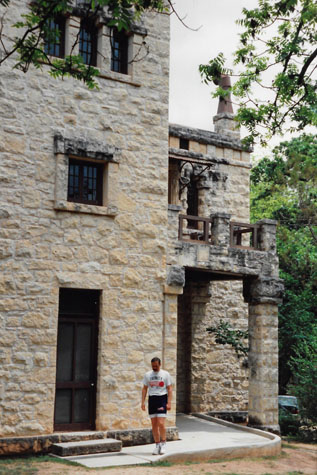 Frank at the Home of Elizabeth Ney |
(Picture at left) In the early 1880s, Ney, by then a Texas resident, was invited to Austin by Governor Oran M. Roberts, which resulted in resumption of her artistic career as she began to seek commissions. In 1892, she built a studio in the Hyde Park neighborhood north of Austin (out of Texas stone, as you can see here) and named it Formosa.
(Picture at right)
|
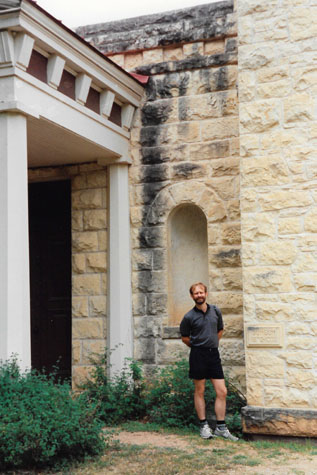 Fred at the Ney Studio |
In 1891, Ney was commissioned by the Board of Lady Managers of the Chicago World's Fair Association, and supplemented with $32,000 by the Texas state legislature, to model Sam Houston and Stephen F. Austin for the Chicago World's Fair in 1893. The marble sculptures of Houston and Austin can now be seen in both the Texas State Capitol in Austin and in the National Statuary Hall Collection in the U.S. Capitol. She sculpted military officer and war hero Albert Sidney Johnston and a statue of Lady Macbeth that is now in the Smithsonian. She even had William Jennings Bryan sit for a portrait.
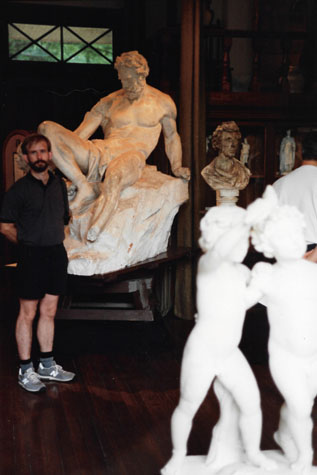 Fred in the Ney Studio |
(Picture at left) Behind Fred is a statue of Prometheus that she did. Oddly enough, I found that Elizabeth Ney has a connection to some of the people who started Davidson College in North Carolina, namely the Ney family. There were a lot of her sculptures around inside, and you could wander throughout the house looking at them. They were not all originals, since many of the originals are still in the parks and on the buildings for which they were constructed.
(Picture at right)
|
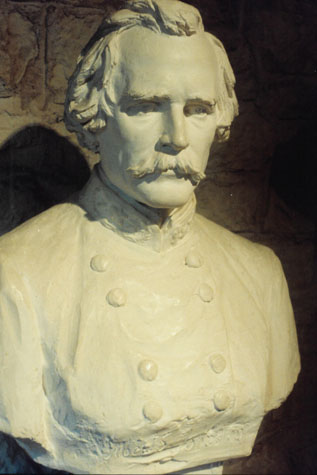 A Ney Scuplture |
While in Heidelberg in 1853, Ney made the acquaintance of a young Scottish medical student, scientist, and philosopher named Edmund Montgomery. It would be a meeting of minds and idealist rebellious spirits. They kept in touch, although she viewed the institution of marriage as a state of bondage for women. He would not be deterred, and after he established a medical practice in Madeira, they were married at the British consulate on November 7, 1863.
Ney, however, remained outspoken about women's roles. She refused to use Montgomery's name and often denied she was even married. Montgomery was diagnosed with tuberculosis in 1863, and in 1871 they emigrated to a town in the US State of Georgia promoted as a colony for consumptives; two sons were born to them after their arrival in the United States. In 1873, the family moved to the Liendo Plantation in Waller County, Texas. Ney died in Austin in 1907 and is buried next to Montgomery, who died four years later, at Liendo Plantation.
A Stop in Bartlett, Texas
|
Bartlett was the site for the filming of movies including The Stars Fell on Henrietta. Don had told us some time ago about this movie (about the Texas oil boom). The filmmakers did a lot of restoration of Bartlett to use it as a set. The particular store shown left of the map was a wreck when we were here in April of last year. Now, many of the buildings on the street where Don has his studio have been repaired and repainted. Many of the displays have been restored to the period of the movie (the 1930s). You can't tell in this picture, but all the items in these windows are reproductions of old stuff.
We missed Don, as he stayed longer in Austin than we did. I may not have mentioned that his lover, Tony Rihn, died in February. I went down to Austin for the service, and met Frank there, although I did not know Don and Tony very well. I was representing both Fred (who couldn't get off work) and myself. Fred and I haven't had a chance to talk with Don much since, and we were sorry to have missed him today- both in Austin and now here.
We continued back to Dallas (eating at a Chinese buffet on the way), and arrived home about eleven. Fred spent the night, and then headed off to work the next day.
You can use the links below to continue to another photo album page.
 |
May 9-12, 1994: A Trip to Washington, D.C. |
 |
March 20, 1994: A Visit to the Dallas Arboretum |
 |
Return to the Index for 1994 |